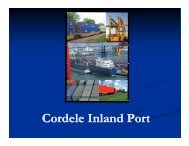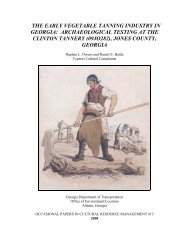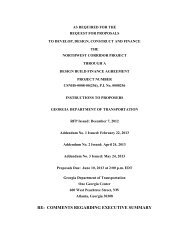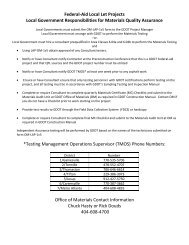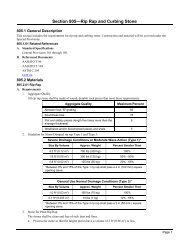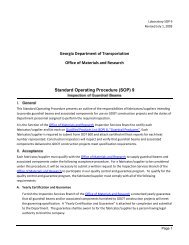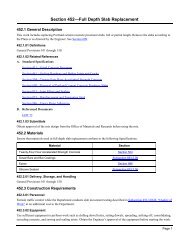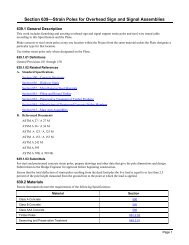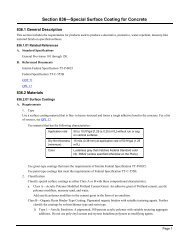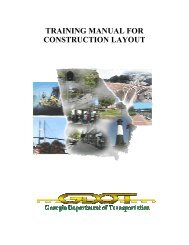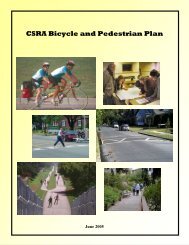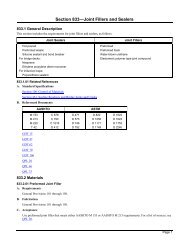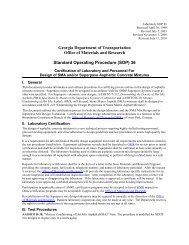Section 660 Sanitary Sewers
Section 660 Sanitary Sewers
Section 660 Sanitary Sewers
You also want an ePaper? Increase the reach of your titles
YUMPU automatically turns print PDFs into web optimized ePapers that Google loves.
<strong>Section</strong> <strong>660</strong>—<strong>Sanitary</strong> <strong>Sewers</strong><br />
<strong>660</strong>.1 General Description<br />
This work includes furnishing materials and installing sanitary sewers and appurtenances.<br />
<strong>660</strong>.1.01 Definitions<br />
House Connection: A sewer pipe from a single building to a common sewer or discharge point.<br />
<strong>660</strong>.1.02 Related References<br />
A. Standard Specifications<br />
<strong>Section</strong> 207—Excavation and Backfill for Minor Structures<br />
<strong>Section</strong> 611—Relaying, Reconstructing, or Adjusting to Grade of Miscellaneous Roadway Structures<br />
<strong>Section</strong> 668—Miscellaneous Drainage Structures<br />
<strong>Section</strong> 801—Fine Aggregate<br />
<strong>Section</strong> 830—Portland Cement<br />
<strong>Section</strong> 841—Iron Pipe<br />
<strong>Section</strong> 842—Clay Pipe<br />
<strong>Section</strong> 843—Concrete Pipe<br />
<strong>Section</strong> 847—Miscellaneous Pipe<br />
<strong>Section</strong> 848—Pipe Appurtenances<br />
B. Related Documents<br />
General Provisions 101 through 150.<br />
<strong>660</strong>.1.03 Submittals<br />
General Provisions 101 through 150.<br />
<strong>660</strong>.2 Materials<br />
Ensure that backfill and foundation preparation materials meet the requirements of <strong>Section</strong> 207.<br />
Ensure that materials meet the requirements of the following Specifications:<br />
Material<br />
<strong>Section</strong><br />
Plastic PVC Sewer Pipe 847.2.07<br />
Concrete Pipe <strong>Sanitary</strong> <strong>Sewers</strong> 843<br />
Cast Iron Pipe <strong>Sanitary</strong> <strong>Sewers</strong> 841<br />
Steel Pipe <strong>Sanitary</strong> <strong>Sewers</strong> 847.2.04<br />
Clay Pipe <strong>Sanitary</strong> <strong>Sewers</strong> 842<br />
Plastic Truss Pipe 847.2.07<br />
Ductile Iron Pipe <strong>Sanitary</strong> <strong>Sewers</strong> 841<br />
Portland Cement 830.2.01<br />
Fine Aggregate for Mortar 801.2.02<br />
Rubber Type Gasket Joints 848.2.01<br />
Resilient Clay Pipe Joints 843<br />
Bolted Couplings 848.2.02<br />
Cement Mortar lining 847.2<br />
Page 1
<strong>Section</strong> <strong>660</strong>—<strong>Sanitary</strong> <strong>Sewers</strong><br />
Material<br />
<strong>Section</strong><br />
Coal-Tar Enamel lining 847.2<br />
Jute and Hemp Joints: Jute and hemp shall be pure, dry, unoiled, and braided.<br />
Ensure that pipe fittings meet the requirements of the section pertaining to the type of pipe used.<br />
<strong>660</strong>.2.01 Delivery, Storage, and Handling<br />
General Provisions 101 through 150.<br />
<strong>660</strong>.3 Construction Requirements<br />
During relocation operations, maintain continuous sewage flow through existing sewer lines. Do not temporarily divert<br />
sewage flow into open trenches or streams.<br />
<strong>660</strong>.3.01 Personnel<br />
A. Pipe Cutting<br />
Have skilled workers cut the pipe.<br />
B. Mechanical Joint Installation<br />
Have an experienced mechanic install mechanical joints.<br />
<strong>660</strong>.3.02 Equipment<br />
General Provisions 101 through 150.<br />
<strong>660</strong>.3.03 Preparation<br />
General Provisions 101 through 150.<br />
<strong>660</strong>.3.04 Fabrication<br />
General Provisions 101 through 150.<br />
<strong>660</strong>.3.05 Construction<br />
A. Excavation, Backfill, and Foundation Preparation<br />
Excavate, backfill, and prepare the foundation according to <strong>Section</strong> 207. In addition, meet the following requirements:<br />
1. Trenches<br />
Excavate the trench as follows:<br />
a. Excavate the trench to provide a maximum width of 8 in (200 mm) on each side of the outside diameter of the<br />
pipe barrel up to 2 ft (600 mm) above the top of the pipe, unless otherwise specified.<br />
b. Shape the trench bottom to fit the pipe.<br />
c. Cut recesses in the trench bottom to accommodate the bells, except on house connections.<br />
d. Ensure that the minimum grade on house connections is two percent unless otherwise specified.<br />
2. Time of Placement<br />
Install sewer pipe on foundation preparation material placed the same day.<br />
3. Excavations on Private Property<br />
a. Carefully excavate within private property easements.<br />
b. Carefully remove sod and topsoil, stockpile it, keep it safe, and replace it in its original position.<br />
c. Leave private property neat and presentable.<br />
B. Laying Pipe<br />
Lay pipe as follows:<br />
1. Lay sewer pipe according to the lines and grades on the Plans, or as established by the Engineer.<br />
2. Lay bell and spigot pipe with bells up grade and spigot ends fully entered into the bells.<br />
3. Lay underground pipe so that at least 25 percent of its barrel circumference is supported for its entire length.<br />
Page 2
<strong>Section</strong> <strong>660</strong>—<strong>Sanitary</strong> <strong>Sewers</strong><br />
4. Install pipe on piers or piles according to Plan details.<br />
C. Jointing<br />
Do not cover joints until the Engineer inspects them.<br />
Before jointing, carefully clean dirt and other undesirable material from the pipe’s interior, including the bell and the<br />
annular space.<br />
When jointing in dry trenches, form joints by one of the following methods when the water level is below the trench<br />
invert and no pumping or bailing is required:<br />
1. Wiped-Joint Method<br />
To use this method:<br />
a. Caulk the joint with jute or oakum dipped in a slurry of cement and water.<br />
Place the caulk.<br />
Use a caulking tool to tightly ram it into the annular space within the pipe socket.<br />
b. Seal the joints, entirely filling the space in the hub around the spigot with mortar.<br />
Use mortar formed of equal parts cement and sand. Mix these dry, then add water to give the proper<br />
consistency.<br />
Mix the mortar in small quantities as required for immediate use.<br />
c. Clean the joint as follows:<br />
Wipe off the joint outside.<br />
On 6 in to 12 in (150 mm to 300 mm) diameter pipe, use a filled bag to remove mortar and debris from<br />
inside. Pull the bag through the line immediately after laying each joint.<br />
On pipe over 12 in (300 mm), wipe the joint inside and outside by hand.<br />
2. Diaper-Joint Method<br />
Caulk according to Subsection <strong>660</strong>.3.05.C.1.a “Wiped Joint Method,” above. Then do the following:<br />
a. Use a common unbleached sheeting material to encircle the pipe bell and a short section of pipe barrel ahead of<br />
the joints.<br />
Form a sheeting envelope by stitching along each edge and adding baling wire into the stitched edges to form a<br />
drawstring.<br />
b. Extend the diaper around the pipe barrel, leaving enough opening in the envelope top for pouring.<br />
c. Draw the wires tightly and secure the envelope firmly against the pipe bell and barrel.<br />
d. Through the opening in the envelope top, pour the joint completely full of Portland cement mortar.<br />
Use mortar formed of equal parts cement and sand.<br />
Mix these dry, then add enough water so that the mortar flows freely into the joint space.<br />
e. Firmly press the mortar into the joint by hand after allowing excess water to drain.<br />
f. Leave the diaper in place permanently.<br />
g. Leave the surface smooth and concentric with the pipe barrel.<br />
h. After the joints have hardened, point up the tops with cement mortar:<br />
Use mortar formed of equal parts cement and sand.<br />
Mix these dry.<br />
Add just enough water to provide workability.<br />
3. Mastic-Joint Method (Hotpoured)<br />
Mastic joints used on concrete or clay pipe shall be as follows:<br />
a. Before jointing concrete pipe, paint the mating surfaces of each joint with bitumen.<br />
b. Caulk pipe joints according to Subsection <strong>660</strong>.3.05.C.1.a.<br />
c. After caulking, heat and pour the mastic compound into the joint using a joint runner or gasket.<br />
Ensure this procedure conforms strictly to the joint compound manufacturer’s recommendations.<br />
Page 3
<strong>Section</strong> <strong>660</strong>—<strong>Sanitary</strong> <strong>Sewers</strong><br />
4. Steel-Bolted Couplings Method<br />
Use steel-bolted couplings for jointing plain end pipe according to Plan details or as specified.<br />
5. Welded Joints<br />
Use welded joints when specified for steel pipe as follows:<br />
a. Ensure that Work, materials, preparation, and workmanship are according to the latest Standard Specifications,<br />
published by the American Waterworks Association and the American Welding Society.<br />
b. Repair coal tar enamel coating damaged by welding heat.<br />
Repair using a field coat of coal tar enamel inside and outside of the pipe.<br />
When the Engineer determines the inside of the pipe is inaccessible, apply repair coating to the outside<br />
only.<br />
6. Mechanical Joints Method<br />
When specified, install mechanical joints for cast iron pipe.<br />
Carefully follow the manufacturer’s instructions and have experienced mechanics install the joint as follows:<br />
a. Wash sockets and spigots with soapy water before slipping glands and gaskets over spigots.<br />
b. Insert the spigot full depth into the socket.<br />
c. Brush the gasket with soapy water and push it into position. Make sure the gasket is evenly seated in the socket.<br />
d. Slide the gland into position for compressing the gasket.<br />
e. Tighten the bolts and nuts.<br />
1) Initially, tighten bolts and nuts finger-tight.<br />
2) Tighten bolts to a permanent tightness with a torque wrench.<br />
3) Tighten bolts alternately 180 degrees apart.<br />
f. Keep socket, spigots, glands, and bolts clean and wet with soapy water until completing each joint.<br />
g. Remake joints that leak. Ensure that each joint meets the leakage test according to<br />
Subsection <strong>660</strong>.3.06.A.2.<br />
7. Push-On Joints Method<br />
Make push-on joints according to the manufacturer’s recommendations.<br />
8. Flexible Watertight Joints Method<br />
Use flexible joints under the roadway, including shoulders and curbs, and according to<br />
Subsection <strong>660</strong>.3.05.C.10. Use the following joints with the specified type of pipe:<br />
Use rubber-type gasket joints with concrete, cast iron, and steel pipe.<br />
Use resilient clay pipe joints with clay pipe.<br />
Place flexible watertight joints as follows:<br />
a. Thoroughly clean mating surfaces, inside and out, before joining the pipe in the trench. Wash cast iron pipe<br />
with soapy water.<br />
b. Apply a manufacturer-recommended lubricant sealer to the mating surfaces.<br />
c. Center the ends and socket to compress the joint, ensuring a tight fit between inner surfaces.<br />
9. Solvent Cement Joints Method<br />
Make these joints according to the manufacturer’s recommendations.<br />
10. Jointing Methods for Wet Trenches<br />
Use one of the following jointing methods when pipe trench conditions require pumping or bailing to maintain the<br />
water level below the trench invert:<br />
Diaper Joint, as in Subsection <strong>660</strong>.3.05.C.2.<br />
Mechanical Joint, as in Subsection <strong>660</strong>.3.05.C.6.<br />
Welded Joint, as in Subsection <strong>660</strong>.3.05.C.5.<br />
Flexible Watertight Joint, as in Subsection <strong>660</strong>.3.05.C.8.<br />
Page 4
<strong>Section</strong> <strong>660</strong>—<strong>Sanitary</strong> <strong>Sewers</strong><br />
D. Connections<br />
Locate connections according to the Plan, or as directed by the Engineer.<br />
Have a skilled worker cut pipe for connections according to the Plans, or as directed by the Engineer.<br />
1. Manhole Connections<br />
Carefully connect new sewer lines to existing manholes and existing sewer lines to new manholes.<br />
Do not allow infiltration of foreign substances.<br />
Thoroughly clean masonry or debris from manholes.<br />
2. Connections Intended for Future Use<br />
Seal and cap connections for future use according to the above requirements for sealing joints. (See<br />
Subsection <strong>660</strong>.3.05.C.)<br />
3. House Connections<br />
Install wyes and tees in common sewer for house connections according to the Plans, or as directed by the Engineer.<br />
Unless otherwise indicated, use 6 in (150 mm) diameter connection ends.<br />
<strong>660</strong>.3.06 Quality Acceptance<br />
A. Sewer lines<br />
Test and repair sewer lines as follows:<br />
1. Test sewer lines, complete in place, with reflected light. Ensure a clear unobstructed view between manholes.<br />
2. Ensure that infiltration does not exceed 1 gal per day per inch diameter per 100 ft of pipe (5 ml per day per<br />
millimeter diameter per meter).<br />
On lines where flow indicates a higher infiltration rate, conduct an Engineer-approved leakage test at the<br />
Contractor’s expense.<br />
3. Repair sewer line with excessive leakage or deviation from line or grade. Repair the leak or deviation at no expense<br />
to the Department.<br />
B. Joints<br />
Ensure that joints are watertight. Immediately repair leaks and defects at the Contractor’s expense.<br />
<strong>660</strong>.3.07 Contractor Warranty and Maintenance<br />
General Provisions 101 through 150.<br />
<strong>660</strong>.4 Measurement<br />
A. Excavation and Backfill<br />
Excavation, foundation preparation material, sand bedding, and normal backfill will not be measured separately for<br />
payment. Their cost is included in the Contract Price for related items.<br />
Foundation backfill materials Type II and imperfect backfill material Type III will be measured for payment according to<br />
<strong>Section</strong> 207.<br />
B. <strong>Sanitary</strong> Sewer Pipe<br />
1. The overall length of pipe installed is measured in linear feet (meters) along the central axis of the pipe diameter.<br />
2. Pipe sections with wyes and tees attached will be included in the measurement.<br />
3. Measurement of house connection lines include bends and riser pipe.<br />
C. Wyes, Tees, and Other Fittings<br />
These Items will be included in the overall pipe measurement.<br />
D. Connections<br />
The cost of making connections, including connections to existing facilities, is included in the Contract Price for sewer<br />
pipe.<br />
Page 5
<strong>Section</strong> <strong>660</strong>—<strong>Sanitary</strong> <strong>Sewers</strong><br />
E. Manholes<br />
<strong>Sanitary</strong> or combination sewer manholes will be measured for payment according to <strong>Section</strong> 668.<br />
F. Adjustment and Reconstruction of Existing Manholes<br />
Adjustment and reconstruction of existing sanitary or combination sewer manholes will be measured according to<br />
<strong>Section</strong> 611.<br />
<strong>660</strong>.4.01 Limits<br />
General Provisions 101 through 150.<br />
<strong>660</strong>.5 Payment<br />
A. Backfill<br />
Foundation backfill Type II and imperfect backfill material Type III will be paid for according to <strong>Section</strong> 207.<br />
B. Manholes<br />
Manholes will be paid for according to <strong>Section</strong> 668. Adjustment of manholes will be paid for according to <strong>Section</strong> 611.<br />
C. Sewer Pipe<br />
Sewer pipe installations, sanitary or combination, complete in place and accepted, will be paid for at the Contract Price<br />
per linear foot (meter).<br />
Payment is full compensation for the Item, including the following:<br />
Furnishing and hauling materials<br />
Excavating and backfilling for all necessary connections<br />
Capping and sealing connections intended for future use<br />
Maintaining continuous sewage flow through existing sewers during relocation<br />
Payment will be made under:<br />
Item No. <strong>660</strong> <strong>Sanitary</strong> sewer pipe_____ in (mm), (type) Per linear foot (meter)<br />
<strong>660</strong>.5.01 Adjustments<br />
General Provisions 101 through 150.<br />
Page 6



